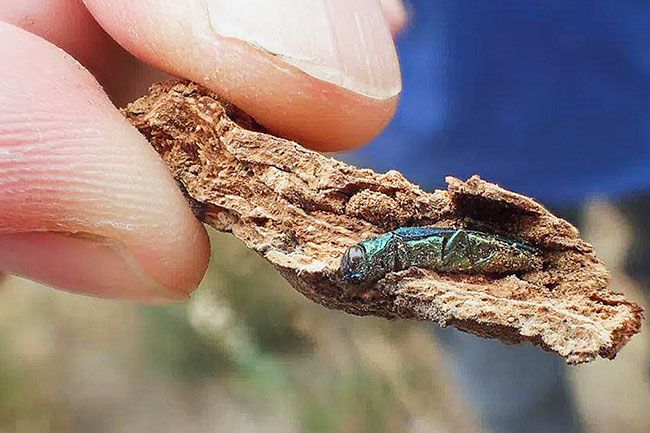Emerald ash borer discovered near Gaston

The invasive emerald ash borer (EAB) pest was discovered in three new Oregon counties this summer, including Yamhill County, according to the Oregon Dept. of Agriculture (ODA) and Oregon Dept. of Forestry (ODF).
The U.S. Dept. of Agriculture (USDA) has officially confirmed the insect in Marion and Yamhill counties, according to an ODA press release. A third site on the border of Clackamas and Marion is believed to harbor EAB. The pest often travels in loads of firewood.
One adult beetle was found in a trap in the Gaston area — one of 197 traps distributed by ODF and USDA APHIS in the Willamette Valley. The federal lab officially confirmed the find as EAB on Aug. 12. The trap was located just inside Yamhill County about seven miles from Forest Grove, where EAB was first detected in Oregon in late June 2022.
ODA is currently working out the details of a quarantine to limit the movement of ash, olive, and white fringe tree wood, and other materials similar to the one in Washington County. That quarantine restricts the movement of several tree materials, including but not limited to logs, green lumber, nursery stock, scion wood, bud wood, chips, mulch, stumps, roots, branches, and firewood of hardwood species.
“We want to protect the rest of Oregon for as long as possible to give communities more time to prepare,” said Cody Holthouse, Compliance and Regulatory Manager at ODA, who chairs the state’s Interagency EAB Task Force.
To slow further spread, Holthouse urges Oregonians to buy firewood near where they intend to burn it and avoid taking firewood more than 10 miles from where it was cut.
A small, metallic-green beetle native to eastern Asia, EAB was first found in the U.S. in Michigan in 2002. It has since killed tens of millions of ash trees across the eastern United States, with death rates up to 99 percent. EAB’s larvae burrow into the bark of ash trees, causing canopy dieback and, ultimately, tree death. The ½ inch beetle is often challenging to detect, especially in newly infested trees. Signs of infestation include thinning and yellowing leaves, bark splitting, D-shaped holes in the tree bark, and basal shoots. Suspected EAB infestations can be reported over the phone at 1-866-INVA.












Comments